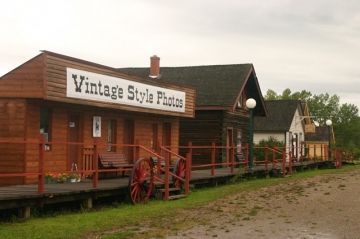Walter Wright Pioneer Village

Park Amenities:
Walter Wright Pioneer Village is a heritage site which explores the history of the early pioneers who settled down in the area of Dawson Creek, British Columbia, Canada. The village is a collection of buildings, artifacts and stories dating back to the early 1900's providing a quick glimpse into the lives and hardships of the early pioneers, miners and trappers.
The historic village is opposite the Rotary Lake Park located on the Alaska Highway at the west entrance of Dawson Creek, BC. The original buildings line up along a recreated "main street". Each building is identified by an interpretive sign and is best accessed by the raised boardwalk pathway connecting to each building.
Some of the notable historic buildings depicting the history of the area include the 1918 Pouce Coupe School from McQueens Lake; the 1920 St. Pauls Anglican Church from the Kilkerran District; 1937 Loiselle Blacksmith Home; the 1928 W.O. Harper General Store; the 1928 Fred & Alice Taylor House from the Spirit River Trail region; the 1916 Dawson Creek School and the 1916 Landry School to name a few.
On the grounds of the park is a good collection of farming and transportation artifacts used by the pioneers of the day. The historic carriages, plows, tractors and wagon wheels line the streets of the village, decorate the grass fields located at the entrance of the village and near the back of the village near the gardens.
Near the church at the far end of the street is a large collection of historic farming equipment and a floral garden named Gardens North. The small flower garden is comprised of eleven themed gardens and a memorial rose garden. There is a small walking path through the gardens and a sitting bench at the entrance.
Onsite is a working coffee shop and an information building. The park is open to self guided tours and for group tours. Reservations are recommended for large groups. There is a public washroom onsite. There is much to see and learn at the Walter Wright Pioneer Village.
Explore and Visit the Walter Wright Pioneer Village in Dawson Creek, British Columbia, Canada
Address:





